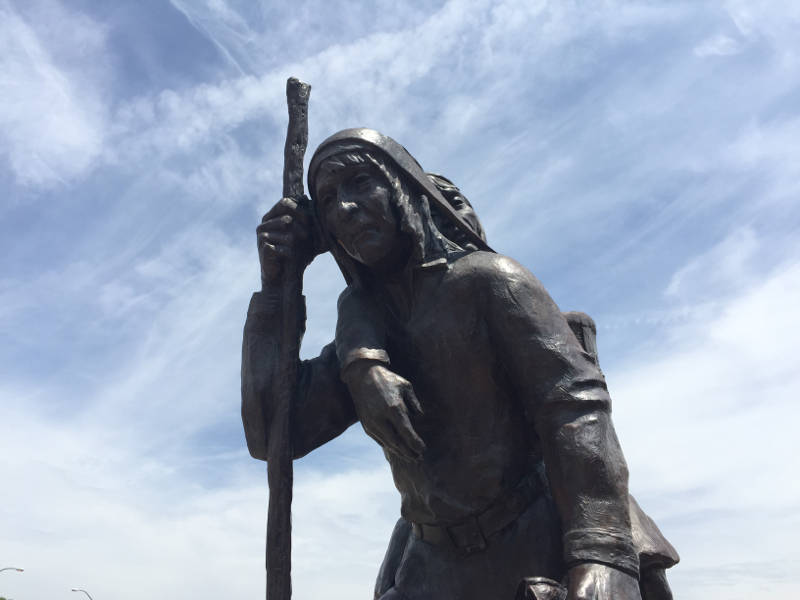
“We’ve been attacked, over and over again,” Vincent Randall said of his people, the Apache.
Randall, who acts as the Apache Culture Director for the Yavapai-Apache Nation, said that since the 1870s, when three major Apache groups in what is now Arizona surrendered to the U.S. government, Apache culture has been targeted for extermination — first, through the removal of spiritual leaders and installation of people “who could be controlled,” and second, through the replacement of traditional beliefs and values with those of the larger culture that came to inhabit the U.S.
No matter how influential teachings from early childhood are, one can imagine how difficult it would be for an Apache child of 8 years old to continue “being Apache” when she is taken from her home, placed in a Christian boarding school on the East Coast and told how to properly grow up, he said.
Separated from all she had known, sometimes not seeing her family for years at a time, what influences from her culture would remain into adulthood?
“The saying is, ‘You take the blanket away from them,’” said Randall, a former YAN chairman, referring to the concept that once a child’s upbringing is removed from them, whitewashed by a more materially powerful culture, that child no longer possesses the “blanket” of their culture and spiritual heritage.
“Some groups completely bought into the system. They really don’t have the basic things they used to have. “It’s a good thing some of our ancestors held onto the old ways …. Lucky for me, my mother held on.”
Randall, whose mother lived in a boarding school from ages 6 to 11, said that he spoke only Apache until he was 6 years old. Now in his 70s, Randall said that seeing the third or fourth generation of his people who speak only English is a reminder of how much work will be required to preserve Apache culture.
According to Randall, language is inextricable from culture and spirituality. The scope of the problem, Randall said, becomes clear when one considers that the youngest fluent Apache speaker — and by fluent, Randall clarified, he means that the person has a high school- or college-level understanding of the language — is 36 years old.
“We’re still pretty strong in our culture and spirituality, but we do have a problem,” Randall said, adding that appealing to the younger generations is difficult given the pervasive influence of American [non-native] culture and technology. “How do we give back to those kids? …. We’re making attempts, but it’s just the tip of the iceberg.”
One of the major attempts Randall and his counterpart, Yavapai Culture Director Gertie Smith, are making is teaching YAN youth Apache and Yavapai languages. Randall and Smith conduct six-week courses for grade schoolers, alternating between the two distinct languages.
In addition, they visit Camp Verde and Mingus Union high schools to teach similar language courses to high schoolers. Randall laments the loss of Apache fluency, describing the Apache language as “instant TV.”
“You tell the same story in English, and it’s not that funny,” Randall said.
The current language courses speak to the entirety of the YAN population, which is spread out in the Middle Verde region of Camp Verde and exists as an isolated reservation in Clarkdale.
As Randall admitted, it’s an uphill battle to address everyone. A huge part of the problem is that the Apache — and the Yavapai, which the U.S. government consolidated along with the Apache in the 1934 Indian Reorganization Act, establishing a single tribe in the upper Verde Valley — lost much of a generation to alcoholism.
As a result, Randall said, there are few men and women in their 80s. Such individuals would once have acted as elders, transferring history, values and religious concepts.
“We’ve lost a lot of ceremonies through our old people passing on with nobody picking [the ceremonies] up,” Randall said.
In addition to Smith, Randall has major allies in the cultural preservation effort: Not only is YavapaiApache Nation Tribal Chairwoman Jane RussellWinieki a vocal proponent of bolstering traditional culture, but Apache communities throughout Arizona regularly share knowledge with one another.
To that end, the communities have together produced language curriculae, documented Apache names and mapped their occurrence, recorded astronomical terms and printed Apache language books on botany and biology. Upcoming editions of the Cottonwood Journal Extra and The Camp Verde Journal will feature a Yavapai perspective on preserving traditional culture.